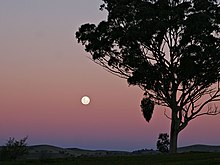ꯊꯥꯅꯤꯜ
Appearance
ꯊꯥꯅꯤꯜ ꯍꯥꯏꯕꯁꯤ ꯊꯥꯒꯤ ꯃꯃꯥꯏ ꯑꯃꯅꯤ ꯃꯂꯦꯝ ꯁꯤꯗꯒꯤ ꯌꯦꯡꯕ ꯃꯇꯝꯗ ꯊꯥ ꯅꯥ ꯃꯄꯨꯡ ꯐꯥꯅꯥ ꯆꯥꯎꯅꯥ ꯀꯣꯏꯅꯥ ꯄꯥꯛꯅꯥ ꯎꯕ ꯃꯇꯝꯅꯤ ꯫ ꯃꯁꯤ ꯃꯂꯦꯝ ꯑꯄꯥꯛꯉꯥ ꯁꯤ ꯅꯥ ꯅꯨꯃꯤꯠ ꯑꯃꯁꯨꯡ ꯊ ꯒꯤ ꯃꯔꯛꯇꯥ ꯆꯞ ꯆꯥꯅꯥ ꯂꯩꯕ ꯃꯇꯝꯗ ꯊꯣꯛ ꯏ ꯫ ꯊꯥꯁꯤ ꯅꯠꯇ꯭ꯔꯒ ꯊꯥꯅꯤꯜ ꯑꯅꯤꯁꯤꯒꯤ ꯃꯔꯛꯁꯤ ꯑꯃꯨꯛ ꯑꯣꯏꯅꯕ ꯌꯥꯡꯆꯠꯇꯥ ꯅꯨꯃꯤꯠ ꯲꯹.꯵꯳ ꯆꯪꯉꯤ ꯫ ꯃꯁꯤꯅꯥ ꯃꯔꯝ ꯑꯣꯏꯔꯒ ꯊꯥꯅꯤꯜ ꯁꯤ ꯊꯥ ꯑꯗꯨꯒꯤ ꯱꯴ ꯄꯥꯟꯕ ꯅꯠꯇꯔꯒ ꯱꯵ ꯄꯥꯟꯕ ꯅꯨꯃꯤꯠꯁꯤꯡꯗ ꯑꯣꯏ ꯫ ꯃꯔꯝꯗꯤ ꯊꯄꯥꯂꯣꯟ ꯒꯤ ꯆꯩꯆꯠ ꯇꯥ ꯊꯥ ꯑꯃꯥꯁꯤ ꯅꯨꯃꯤꯠ ꯲꯹ ꯅꯠꯇꯔꯒ ꯅꯨꯃꯤꯠ ꯳꯰ ꯑꯣꯏꯕꯒꯤꯅꯤ ꯫


ꯐꯨꯡꯒꯥ ꯋꯥꯔꯤ ꯑꯃꯁꯨꯡ ꯆꯠꯕꯤꯗ
[ꯁꯦꯝꯒꯠꯂꯨ | ꯁꯦꯝꯒꯠꯂꯛꯄꯒꯤ ꯍꯧꯔꯛꯐꯝ]
ꯂꯧ ꯂꯣꯛꯄꯥ ꯑꯃꯁꯨꯡ ꯁꯥꯇꯥꯟꯕ ꯊꯥ
[ꯁꯦꯝꯒꯠꯂꯨ | ꯁꯦꯝꯒꯠꯂꯛꯄꯒꯤ ꯍꯧꯔꯛꯐꯝ]
ꯂꯧꯔꯛꯐꯝꯁꯤꯡ
[ꯁꯦꯝꯒꯠꯂꯨ | ꯁꯦꯝꯒꯠꯂꯛꯄꯒꯤ ꯍꯧꯔꯛꯐꯝ]- ↑ cite web|url=https://web.archive.org/web/20160303230520/http://www.research.utoronto.ca/harvest-moon/ |title=Why is the harvest moon so big and orange? |date=27 September 2010 |publisher=University of Toronto |last=Percy |first=John
